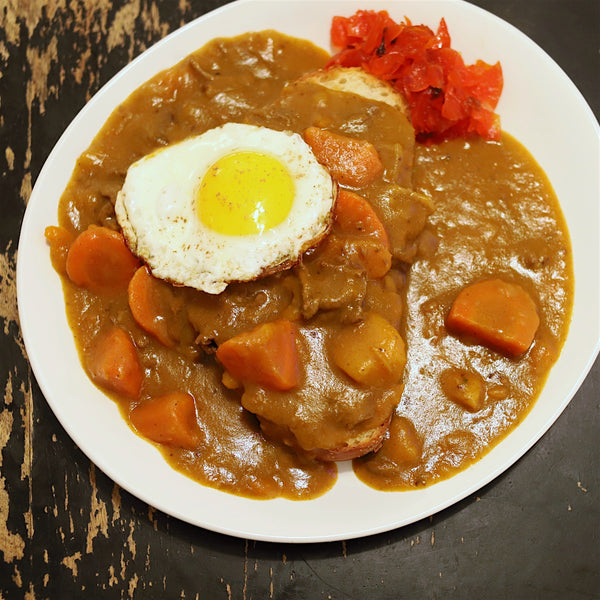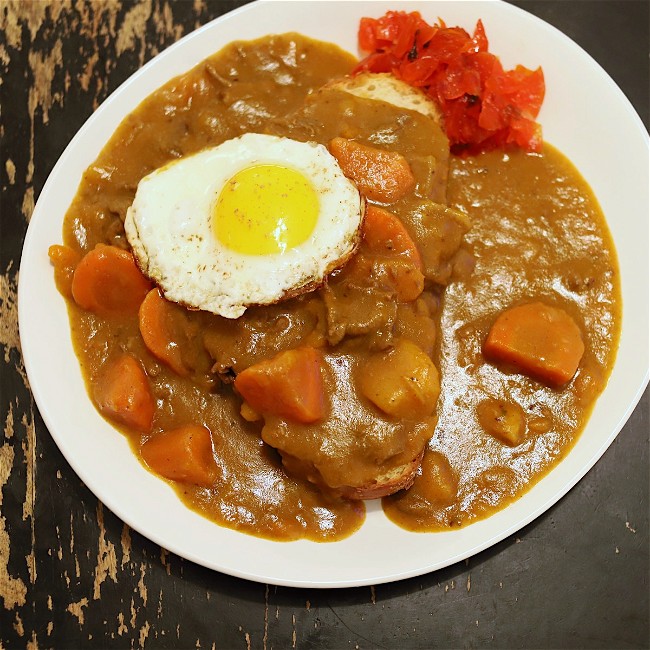
Japanese Curry
I grew up eating Japanese curry (it’s one of the most popular meals to cook at home in Japan). It’s a curious dish when you actually look at the ingredients; usually made with meat, carrots, and potatoes, and thickened with a roux, quite unlike any other curry I’m aware of. I have a huge soft spot for it as growing up it was a way to share my heritage in a way that was delicious and accessible to people in the US. Japanese ingredients give the curry a unique flavor, and I think once you’ve had it this might become a go-to meal for you much as it is for me.
Category
Dinner
Servings/Yield
4
Author
Christian Leue

Ingredients
1 tsp neutral oil for frying
1 pound thinly sliced beef (chuck or ribeye), chicken (thigh or breast meat), or pork (shoulder or belly)
1 pound onion, peeled and cut into thin slices
1 pound carrot, scrubbed, peeled and cut into bite sized pieces
1 pound potato (yukon gold or russet), scrubbed, peeled and cut into bite sized pieces
1 dashi stock packet – This is also what you want to use when making miso soup, and is a great addition to many western soups as well. Be aware that many commercial dashi powders and stocks are made from yeast extract and/or MSG, and will be less complex in flavor (think vanilla extract vs. imitation vanilla).
Water, (sufficient to cover the meat and vegetables)
1/2 stick butter (my preference) or two ounces neutral oil (for a dairy free option)
1/2 cup all purpose flour
-
2 Tbsp Massalis, finely ground
1 Tbsp Worcestershire sauce
1 Tbsp mirin
1 Tbsp soy sauce (for the best flavor look for ones that contain only soybeans, wheat, and salt, and keep the bottle in the fridge once opened)
Cooked Japanese rice
Pickles (rakkyo and fukujinzuke) for serving (optional but great)
The Curry
The Roux*
To Serve
Directions
Mottainai tip – Optionally, you can make a quick stock from the skins of all of your vegetables and any meat scraps, adding water to cover. If you go this route add the dashi stock bag to this pot. Strain the solids after about 30 minutes of simmering and reserve the liquid, you’ll probably have about 4 cups total.
In a skillet over medium heat add the oil then fry the meat in batches until lightly browned, making sure not to crowd the pan and removing the cooked meat to a 4 quart saucepot. Fry the onions in the skillet until softened and lightly browned, then deglaze with 1/2 cup water and transfer everything to the saucepot along with the carrot, potato, and the stock if you made it (or the stock bag if you didn’t), then add water until the solids are barely covered. Bring to just below a boil, then drop to a simmer.
For the roux: In the skillet you used to cook the onions add the butter (or oil) and flour, and cook while stirring over low heat for 12-15 minutes, or until light blonde in color. Add the spices and cook for a minute more, then add the Worcestershire, mirin, and soy sauce, mix well, and remove from heat. If you made a larger batch, remove the extra roux to storage containers now.
Once the vegetables are tender (about 30 minutes), remove and discard the dashi stock bag (if you didn’t make the stock mentioned above), and remove about a cup of the broth to your skillet and stir well to dissolve the roux, then transfer everything back to the pot. This method eliminates the possibility of undissolved blobs of roux in your curry.
Allow the curry to cook for about 5 minutes more, stirring gently. The roux will thicken the broth as it heats. Adjust to taste with additional worcestershire, mirin, and soy sauce, if desired.
Serve with Japanese rice (a traditional serving), or over a thick piece of buttered toast, topped with a soft fried egg (our house favorite, pictured), or over a roasted quarter of a cauliflower (for a lighter option).
If you like more heat, a sprinkle of Aleppo or Espelette is very nice.
Serve with pickles to add a bright element. The pickles I mentioned in the ingredients list are traditional Japanese pickles, and are lightly sweet to complement the mild heat of the curry. I’ve found that bread and butter pickle chips, rinsed of excess vinegar then tossed with a bit of soy sauce, work well also.
Recipe Note
Recipe Notes:
* Note that the roux recipe can be doubled or quadrupled to make more at once to store for a later date. Keep in tightly sealed containers in the fridge for up to 2 months, or the freezer for up to a year. You can even shape them into blocks if you like, like the commercial product.
Variations & Ideas:
The recipe above is a basic one, and you can have a lot of fun adding or substituting other ingredients. Some that work great include: chunks of kabocha squash, cauliflower florets, mushrooms, peas, pearl onions, grated apple (this adds a subtle sweetness), eggplant, sautéed spinach. It’s a great way to introduce children to vegetables as most kids like the flavor of mild curry and the sauce makes a comforting backdrop for novel foods.
Curry puffs: Allow the curry to cool, then chop and larger chunks into small pieces and place in a cool area of the refrigerator to firm up. Buy or make puff pastry. Roll out a thin sheet and cut out squares or circles and wrap them around spoonfuls of curry, then place on a parchment coated baking sheet and bake at 350°F until lightly browned. They can also be frozen uncooked and cooked straight from the freezer for a quick meal, just add a few minutes to the bake.
Baked curry. Make curry but substitute ground chuck or ground chicken thigh for the meat. Layer a casserole dish with cooked rice, bread cubes, or pasta, top with the curry and some grated cheese (mozzarella and/or jack are both great) and bake at 350°F until browned and bubbling. Also great with a soft fried egg on top.
Questions about this recipe? Contact us at info@laboiteny.com


